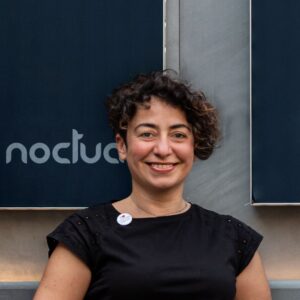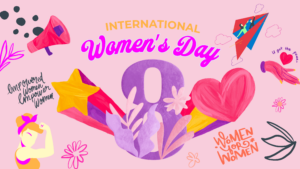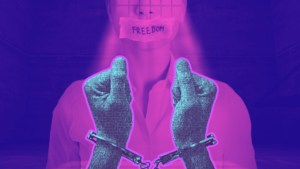Lighting surrounds us, yet one rarely thinks about it—until something changes. Imagine a woman walking home late at night. A streetlight flickers and dies, plunging her path into shadow and leaving her with a sinking sense of vulnerability. Or picture a child gazing at a monument, its lights revealing hidden stories and sparking quiet wonder. Lighting shapes how we feel—fearful or safe, indifferent or inspired—proving it’s so much more than a backdrop to our lives.
Lighting design in public spaces is more than illuminating dark areas. When approached thoughtfully, it becomes a powerful tool for transformation. Beyond traditional lighting practices, a transdisciplinary, community-centered design process has proven effective and viable. Lighting is not just a tool for navigation; it shapes how we interact with public spaces, influences how safe and welcoming these spaces feel, and can even support long-term ecological goals (Casciani & Rossi, 2013; Brandi & Geissmar-Brandi, 2007).
As we think about designing spaces to be experienced 24/7, we should also account for the complex relationship between the built environment and its surrounding natural systems. Spaces should not only function effectively but also achieve sustainability by harmonizing human needs with ecological priorities. In this way, lighting design becomes a key driver in creating urban environments that are safe, inclusive, and environmentally responsible (Roger, 2017).
Inclusive Design: Illuminating Diverse Experiences
Inclusive lighting design takes into account the needs of all users, particularly those often overlooked in urban planning. Women, children, the elderly, and people with disabilities—beyond just those with visual impairments—often experience public spaces differently, especially after dark. This disparity is heightened when we consider how variations in lighting directly influence people’s perceptions of security, comfort, and freedom to navigate.
Achieving perceived safety requires more than simply increasing brightness. Poorly designed lighting, whether overly illuminated or inexpertly distributed, can create environments that exacerbate feelings of insecurity instead of alleviating them (UNHR, 2024; London School of Economics, 2017). Harsh contrasts, glare, and lack of visual hierarchy may discourage the usage of public spaces, amplifying feelings of exclusion and vulnerability (Machielse, 2015).
Lighting for Safety and Empowerment
Surveys and studies have consistently highlighted this issue, showing that inadequate lighting often deters women and other vulnerable groups from using parks, pathways, and even urban centers after dark (London School of Economics, 2017). These findings underline the critical role that lighting plays not just in fostering accessibility but also in shaping equitable urban experiences. By prioritizing inclusive lighting strategies, we can transform how diverse user groups interact with public spaces, ensuring their needs are integrated rather than sidelined (Machielse, 2015).
Beyond these technical aspects, inclusive lighting becomes a tool for empowerment when it tackles psychological perceptions of safety. Regardless of background or abilities, everyone should feel comfortable and confident in public spaces (Boomsma & Steg, 2012). Lighting design can help create spaces that not only feel safer but are more inclusive and welcoming to all.
Through participatory design practices, lighting design captures the unique needs and insights of marginalized communities, resulting in more effective solutions. Engaging them in the process not only elevates their voices but also encourages their ownership of public spaces and deepens emotional connections to shared spaces, fostering a sense of belonging (London School of Economics, 2017; van Rijswijk & Haans, 2018).
Perceptions of Safety: Moving Beyond Visibility
Creating safe spaces should go beyond enabling people to occupy or use them; it should empower individuals to feel a deep sense of trust, confidence, and ownership in these environments. By fostering such a shift, lighting design can help transform spaces into places where people feel safe, empowered, and connected.
As highlighted in the UNHCR Safe Design Guidelines, lighting directly impacts more than visibility; it influences psychological perceptions of safety, particularly in vulnerable contexts (UNHR, 2024). In refugee camps, for instance, lighting has reduced the risks of gender-based violence and theft in areas like latrines, cooking stations, and water points. These same principles apply in urban settings, such as bus stops. Strategic lighting choices—such as ensuring people can clearly distinguish obstacles or identify colors—are as crucial as illuminating the face of an approaching individual to foster a true sense of security (Roger, 2017).
Moreover, well-designed lighting reinforces a sense of belonging by aligning with the needs of different user groups. Public spaces that feel safe and welcoming encourage interaction, reduce isolation, and foster stronger social cohesion (Claris & Scopelliti, 2016). In urban areas, well-lit— in terms of quality— gathering spaces, playgrounds, and pathways transform environments into community hubs, counteracting the isolating effects of inadequate infrastructure (Boomsma & Steg, 2012; van Rijswijk & Haans, 2018).
Case Study: Participatory Planning in Fröslunda, Sweden
The project in a disadvantaged neighbourhood exemplifies how inclusive design transforms spaces. Collaborating with landscape architect Malin Christensson, participatory planning with the community helped redesign a previously unsafe path into an inclusive, welcoming corridor. The team conducted workshops involving 70 children and young women in several activities, from analysing their routes to school to assessing their concerns about the area.
This participatory process not only informed the lighting design but also fostered a sense of ownership within the community. For example, artwork by one of the children was incorporated into the lighting fixture shades, providing a lasting symbol of inclusion. By addressing the concerns of specific user groups and integrating their feedback, the project created a space that felt both safe and welcoming, reinforcing the value of inclusive design, especially after dark.
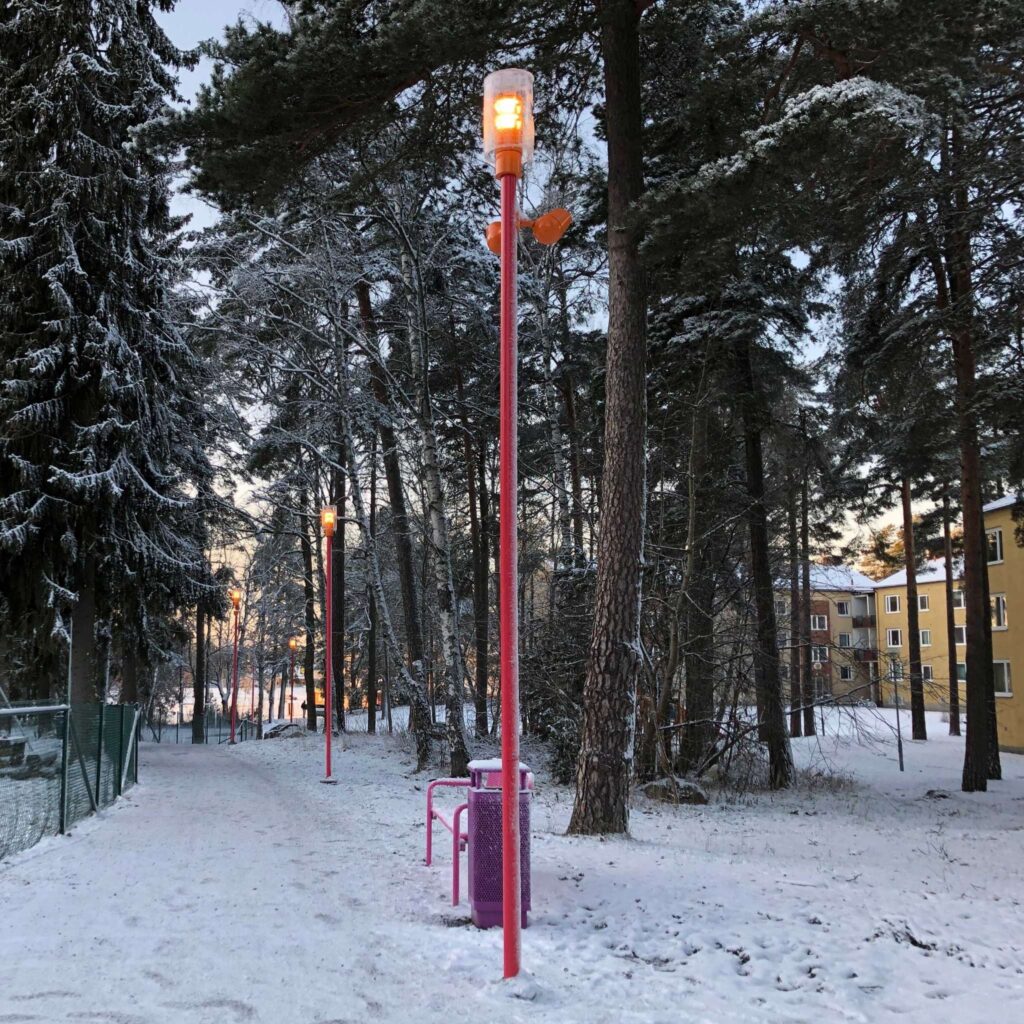
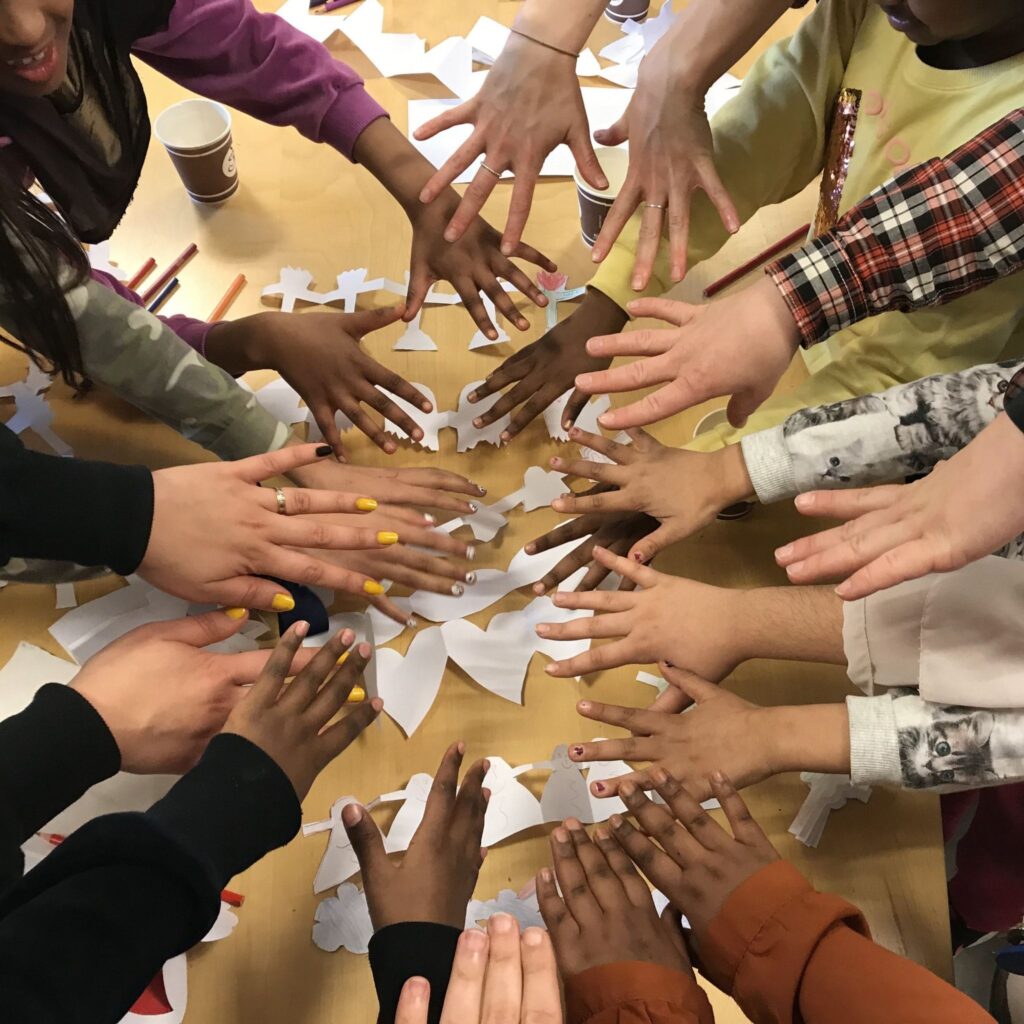
Images by Chiara Carucci
Rethinking the Nightscapes Experience
Historical Context: The Evolution of Urban Lighting
The introduction of electric light in the early 20th century marked a significant transformation in how cities functioned after dark. Artificial lighting extended daytime activities into the evening, enabling urban nightlife to thrive and introducing safety concerns. In response, early lighting installations were designed to “banish darkness” based on the belief that brighter spaces were inherently safer (Brandi & Geissmar-Brandi, 2007; Machielse, 2015).
As car use increased in the 20th century, urban lighting schemes prioritized driver visibility, resulting in high-intensity light poles placed at regular intervals. While this approach advanced mobility, it often overlooked the needs of pedestrians and other vulnerable groups, leaving spaces feeling cold and impersonal (Casciani & Rossi, 2013; Roger, 2017).
Contextual and Adaptive Lighting Strategies
One of the most pervasive misconceptions in lighting is the belief that “more light equals more safety.” As emphasized earlier, safety is not about quantity but quality (Boomsma & Steg, 2012; van Rijswijk & Haans, 2018). Instead of relying on blanket solutions, lighting design should emphasize contextual sensitivity. This approach considers the unique characteristics of each space—its layout, user demographics, and surrounding environment (London School of Economics, 2017; Machielse, 2015). Informed lighting enhances accessibility, highlights key areas—for instance, escape routes and landmarks—and ensures that people feel secure.
Among other aspects, we should also consider the movement patterns of different users—whether they are pedestrians, cyclists, or drivers—and design light to complement these movements (Claris Susan, 2016; van Rijswijk & Haans, 2018). Moreover, adaptive lighting solutions, which adjust based on the time of day, season, and activity levels, offer a more dynamic and responsive approach to public lighting. By tailoring light levels to the actual needs of a space, these systems improve safety while reducing energy use and minimizing environmental impact (Machielse, 2015; UNHR, 2024).
Environmental Considerations: Lighting in Ecological Balance
While addressing social needs, lighting design must consider environmental sustainability beyond energy efficiency. Excessive or poorly directed lighting contributes to light pollution, disrupting ecosystems and wasting energy. From confusing migratory birds to disrupting the behavior of nocturnal animals, the ecological consequences of artificial light at night cannot be ignored (Roger, 2017; Longcore & Rich, 2004).
Research consistently shows that reducing light pollution improves ecosystem health by preserving natural rhythms and reducing disturbances to wildlife (Boomsma & Steg, 2012; Roger, 2017). This approach also benefits humans: lighting enhances visibility by minimizing glare and light trespass, creating safer and more comfortable public spaces. Informed lighting serves as a bridge, aligning ecological and social objectives and crafting spaces that support conservation while fostering human safety and comfort (Machielse, 2015; van Rijswijk & Haans, 2018).
Case Study: Hamngatan and MDU Plaza
Hamngatan and MDU Plaza, a collaborative endeavor in Eskilstuna, Sweden, exemplifies the principles of informed lighting design. The project aimed to transform a key area connecting the new university entrance with a public plaza—formerly a parking lot—along the river into a vibrant, welcoming space. Prior to commencing the project, the city’s landscape architect conducted interviews with students and university representatives and solicited input from citizens through an online survey.
These efforts provided a comprehensive understanding of the site’s dynamics and user aspirations, forming the foundation for the lighting design process. Being involved early in the project, we considered both ecological concerns and user needs from the start. The resulting lighting design was not only functional but also enriched the experience of the space. Increased foot traffic benefited local businesses, while public events gained a more engaging atmosphere.
This project increased security and transformed the area into a vibrant and inviting space. It also gained international recognition, earning second place in the prestigious LUCI Awards 2024. This acknowledgement highlights how thoughtful lighting design can balance ecological sensitivity with social impact, setting a benchmark for future urban projects.
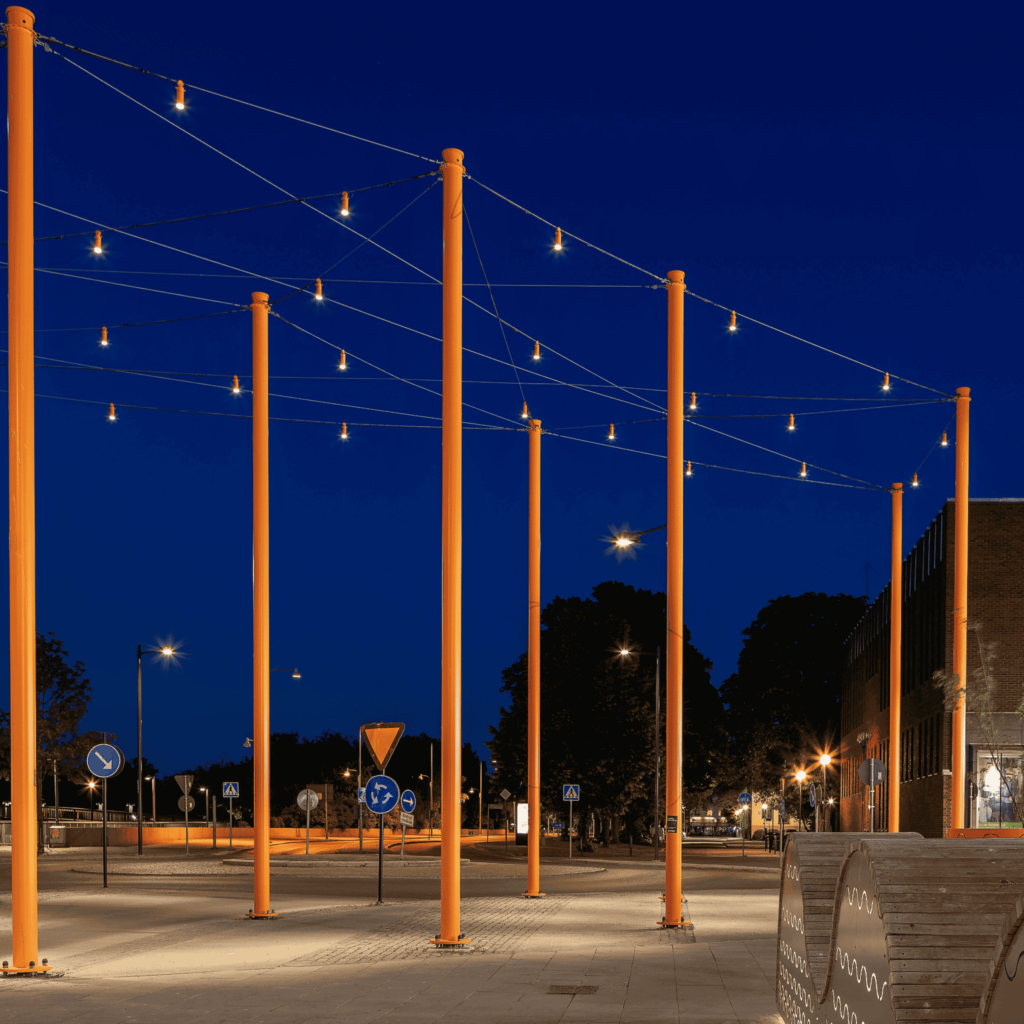
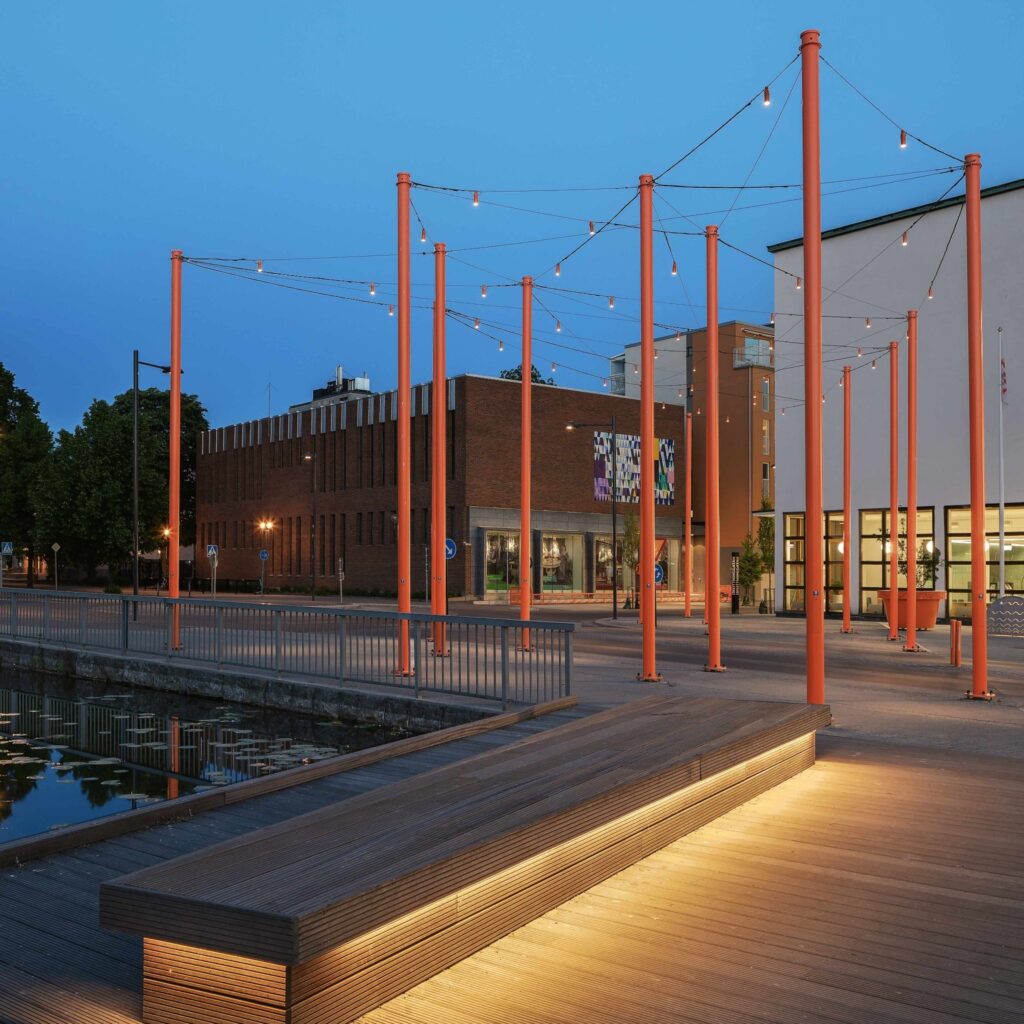
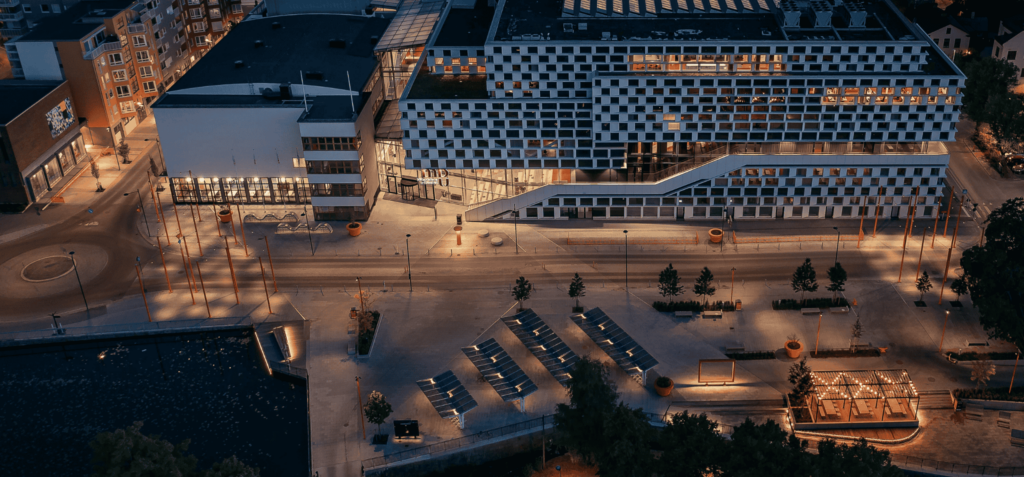
Images by Chiara Carucci
Tartu Valgus: My Lessons Learned
During the Tartu Light Festival TAVA24, I had the opportunity to support a three-day workshop for students, primarily young women from the local art school. Together, we explored the transformative power of light and translated these insights into a temporary installation for the festival. While the participants shared that they felt safe walking home at night— Tartu is indeed one of the safest parts of Estonia—work remains to be done to empower vulnerable groups.
As part of the festival, I also hosted tours around Toomemägi Hill, including the new lighting of Toomkirik, Koit ja Hämarik, a project I contributed to that recently won the LIT Lighting Design Award in the Heritage category. These tours revealed how the new lighting and the refurbishment of the historical lanterns, thanks to Tartu municipality, benefit everyone, including those crossing the park late at night. However, light pollution remains a significant challenge in the city, affecting both wildlife and human well-being by disrupting natural rhythms and sleep patterns.
Although I didn’t have the chance to explore Tartu’s suburbs, participants in my “Walk & Talk” events mentioned that there should be more attention to lighting for the people rather than cars. While many residents are conscientious about wearing reflective ornaments, I believe everyone should feel safe everywhere, not only when crossing streets. I urge raising awareness of the importance of designing lighting solutions that cater to people’s needs, creating environments that are not only functional but also inviting and equitable for all.
Conclusion: Lighting Our Way Forward
It is not just us, lighting professionals, who hold the power to shape our spaces after dark. Urban and landscape architects, citizens involved in policymaking, and anyone with a voice in community planning all have a vital role to play. Together, we can take ownership of this shared responsibility to co-create spaces that are socially yet environmentally sustainable and welcoming for all.
Informed lighting design is a transformative tool for shaping public spaces that are equitable, sustainable, and inclusive. By involving communities, challenging assumptions, and embracing multidisciplinary collaboration, we can reimagine nightscapes—serving people and protecting the environment (Brandi & Geissmar-Brandi, 2007; UNHR, 2024; van Rijswijk & Haans, 2018). Let’s embrace this challenge and light the way toward an enlightened and more inclusive future 24/7 (Claris & Scopelliti, 2016).
Bibliography
Boomsma, C. & Steg, L. (2012). Feeling Safe in the Dark. https://doi.org/10.1177/0013916512453838
Brandi, U. & Geissmar-Brandi, C. (2006). Light for Cities: Lighting Design for Urban Spaces. A Handbook. https://doi.org/10.1007/978-3-7643-8263-6
Daria, C. & Rossi, M. (2013). ELSE, Experience of Lighting Sustainability in the Environment.
Claris, S. & Scopelliti, D. (2016). Cities Alive: Towards a walking world.
London School of Economics. (2017). Configuring Light.
Machielse, W. (2015). Perceived safety in public spaces : A quantitative investigation of the spatial and social influences on safety perception among young adults in Stockholm.
Roger, N. (2017). Architectural Lighting magazine – Imagining the future of the City at night. https://www.researchgate.net/publication/379644837_Roger_Narboni_-_Architectural_Lighting_magazine_-_Imagining_the_future_of_the_City_at_night_-_Feb_2017
Longcore, T., & Rich, C. (2004). Ecological light pollution. Frontiers in Ecology and the Environment, 2(4), 191-198. https://doi.org/10.1890/1540-9295(2004)002[0191:ELP]2.0.CO;2
UNHR. (2024). Safe and Secure Settlements | UNHCR. https://emergency.unhcr.org/emergency-assistance/shelter-camp-and-settlement/protection-considerations-integrated-settlement/safe-and-secure-settlements
Van Rijswijk, L. & Haans, A. (2018). Illuminating for Safety: Investigating the Role of Lighting Appraisals on the Perception of Safety in the Urban Environment. Environment and Behavior, 50(8), 889–912. https://doi.org/10.1177/0013916517718888

